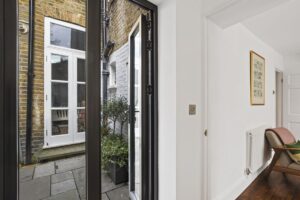When designing your new side return extension, give some thought to heating and privacy. There are many options for both issues – here are some:
HEATING
To keep the new extra space nice and snug, you will need to add additional heating to that area. Yes you can add traditional wall mounted radiators – there are some fantastic modern looking ones on the market now. Another option, if you have access to a chimney (or space for a twin wall flue) is a log-fired stove. But for a really snug feel, there’s nothing like underfloor heating.
Underfloor heating provides an evenly balanced heat source for a kitchen extension. The manner in which it is installed means that the water flowing around the floor is a reduced temperature to the rest of the house, meaning that the pipes in the floor distribute an evenly balanced heat, whilst the floor tiles remain warm, rather than hot under foot.
Benefits:
- Greater efficiency (manufacturers quote energy savings of around 20% compared to standard radiators)
- Space saving – no awkward radiators to obstruct the kitchen planning
- Evenly balanced heat
- Warm underfoot (kids love playing on a heated floor!)
- The floor slab acts as a retained heat source by virtue of the embedded insulation beneath. This means the room is often nice and warm in the morning, even after a cold wintery night.
Considerations:
- Never, ever, think of installing an electric heat mat system – it will be very costly to run and will heat the tile, not the room. Good for bathrooms, dreadful for kitchen extensions.
- Make sure the underfloor heating is installed on a separate zone – so that it can be independently controlled from the rest of the house.
- Underfloor heating works best with a tiled or natural stone floor. It can also work with timber flooring, but as timber acts as a natural source of heat retention, it is advisable to select an engineered timber floor as opposed to a solid wood floor.
PRIVACY
If one of the reasons you are deciding to build a side return extension is to let in more natural daylight, then you may want to consider how to balance that with privacy issues. If you are out of sight of your neighbours then you may decide not to bother with any window treatments at all. But even if are not overlooked, you still may choose some type of curtain or blinds to help control the indoor climate. Here are some new options to consider:
Velux windows
Many side return extensions have velux windows built in. Whatever your preference, there is a great selection of specially designed blinds that enable you to control your privacy and the amount of daylight your room receives.
For example:
-
-
-
-
- Venetian blinds – enable you to adjust the light to your preference.
- Pleated blinds – enable you to soften the light.
- Roller blinds – enable you to diffuse the light.
- Blackout blinds – enable you to block out the light completely.
-
-
-
The blinds will also help control heat intake and heat loss to save energy and contribute to improving your room’s indoor climate. Increasingly popular are the electric and remote control blinds that can be controlled at the touch of a button.
Integral Blinds in Bi-fold and Patio doors
If you prefer the un-cluttered look, consider installing bi-fold doors with integral blinds. Maintenance, dust and allergy-free, integral blinds are assembled and permanently sealed within the double glazing cavity of the doors. The blinds provide sun and daylight shading and improve the u-value of the glazing units.
Integral blinds are modern and stylish and best of all don’t need to be dusted or cleaned as traditional blinds do. The blinds can be raised, lowered or tilted manually or automatically.
When it comes to Fixtures and Fittings, Build Team always give you the choice. If you wish, we can supply them for you, or you can order them yourself, in which case we will let you know when the items are required on site.






















